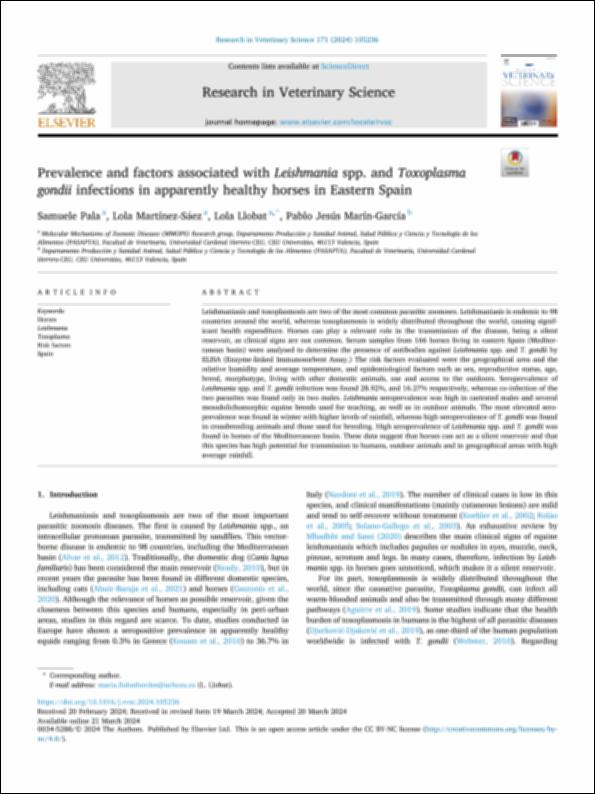Por favor, use este identificador para citar o enlazar este ítem:
http://hdl.handle.net/10637/15892Prevalence and factors associated with "Leishmania spp." and "Toxoplasma gondii" infections in apparently healthy horses in Eastern Spain
| Título : | Prevalence and factors associated with "Leishmania spp." and "Toxoplasma gondii" infections in apparently healthy horses in Eastern Spain |
| Autor : | Pala, Samuele Martínez Sáez, Lola Llobat Bordes, Lola Marín García, Pablo Jesús |
| Materias: | Leishmaniasis; Toxoplasmosis; Enfermedad animal; Animal diseases; España; Spain; Caballo; Horses; Zoonosis; Zoonoses |
| Editorial : | Elsevier |
| Citación : | Pala, S., Martínez-Sáez, L., Llobat, L. & Marín-García, P.J. (2024). Prevalence and factors associated with "Leishmania spp." and "Toxoplasma gondii" infections in apparently healthy horses in Eastern Spain. Research in Veterinary Science, vol. 171 (may.), art. 105236. DOI: https://doi.org/10.1016/j.rvsc.2024.105236 |
| Resumen : | Leishmaniasis and toxoplasmosis are two of the most common parasitic zoonoses. Leishmaniasis is endemic to 98 countries around the world, whereas toxoplasmosis is widely distributed throughout the world, causing significant health expenditure. Horses can play a relevant role in the transmission of the disease, being a silent reservoir, as clinical signs are not common. Serum samples from 166 horses living in eastern Spain (Mediterranean basin) were analysed to determine the presence of antibodies against Leishmania spp. and T. gondii by ELISA (Enzyme-linked Immunosorbent Assay.) The risk factors evaluated were the geographical area and the relative humidity and average temperature, and epidemiological factors such as sex, reproductive status, age, breed, morphotype, living with other domestic animals, use and access to the outdoors. Seroprevalence of Leishmania spp. and T. gondii infection was found 28.92%, and 16.27% respectively, whereas co-infection of the two parasites was found only in two males. Leishmania seroprevalence was high in castrated males and several mesodolichomorphic equine breeds used for teaching, as well as in outdoor animals. The most elevated seroprevalence was found in winter with higher levels of rainfall, whereas high seroprevalence of T. gondii was found in crossbreeding animals and those used for breeding. High seroprevalence of Leishmania spp. and T. gondii was found in horses of the Mediterranean basin. These data suggest that horses can act as a silent reservoir and that this species has high potential for transmission to humans, outdoor animals and in geographical areas with high average rainfall. |
| URI : | http://hdl.handle.net/10637/15892 |
| Derechos: | http://creativecommons.org/licenses/by-nc/4.0/deed.es Open Access |
| ISSN : | 0034-5288 1532-2661 (Electrónico) |
| Cubierto por: | Acuerdo Transformativo – 2024 |
| Fecha de publicación : | may-2024 |
| Centro : | Universidad Cardenal Herrera-CEU |
| Aparece en las colecciones: | Dpto. Producción y Sanidad Animal, Salud Pública Veterinaria y Ciencia y Tecnología de los Alimentos |
Los ítems de DSpace están protegidos por copyright, con todos los derechos reservados, a menos que se indique lo contrario.


